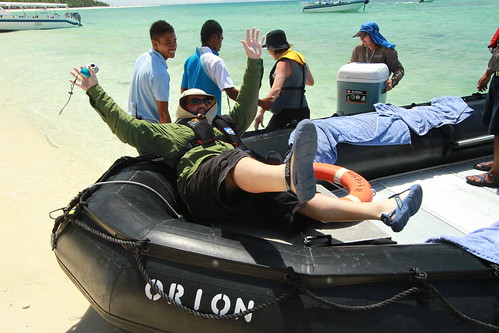Zodiac 101: Getting ashore
 |
| Zodiac cruising in calm Antarctic waters (R Eime) |
by Roderick Eime
The vexing question of Zodiac operations is one of the most-asked questions by prospective expedition cruise passengers and one of the common hand-wringing reasons some travellers decide against expedition cruising. What am I talking about? Read on.
 |
| Unloading to gangway. Proper handholds are critical. (R Eime) |
What is a Zodiac? The trade-marked, patented Zodiac tender is an inflatable rubber runabout powered by an outboard motor and skippered by a single crewmember who steers by a ’tiller’ (a throttle/handle attached to the motor). These aren’t something you blow up and play with in the backyard pool. They are military-grade boats used by commandos in the worst conditions. They are designed for seriously heavy duty operations, are remarkably stable and virtually unsinkable. For ferrying camera-toting tourists on shore excursions, they are way over-specified.
Almost without exception, any ship you select for your expedition cruise will be equipped with several of these boats to land guests on beaches, rocky outcrops or tiny jetties too small for the ship to tie-up. It’s a fact you have to face if you intend to go ashore during your cruise.
I’ve been in and out of more Zodiacs than I can remember over the last 15 years of adventure cruising and most problems are due to passengers not following instructions or doing something stupid. Operator skill and experience is another factor, although Zodiacs are pretty easy to operate in calm conditions. It’s only when things get rough and windy that the best operators are required.
 |
| Pay attention to crew instructions or you’ll end up like this dunce. (Mick Fogg/Wallacea Expeditions) |
Your selected cruise operator will give all passengers a detailed Zodiac briefing in advance of the first landing, so make sure you are present for that – and pay attention! You’ll get detailed instructions on what clothing to wear, use of the special life jacket (which you must wear) and how the specific ships’ boarding process works. It could be a step-type gangway from the deck or a stern transom (platform).
There isn’t room here to go through the whole operation, but if you are considering an expedition cruise, particularly in the polar regions, you need to be comfortable with this process or you will be a hazard to yourself and the other passengers. Unfortunately not all cruise consultants are able to accurately assess your suitability for Zodiac operations. They are sales people after all and may not have ever been in a Zodiac themselves.
| Boarding a Zodiac on shore. This is a wet landing. (R Eime) |
In general terms and taking into account the worst possible conditions, passengers with mobility issues should think carefully about their suitability for Zodiac travel. In many cases, you’ll need to climb a narrow gangway that could be wet and slippery and moving about slightly, then step onto the pontoon of the Zodiac which could also be moving up and down slightly (or a lot!). Yes, there are always staff and/or ship’s sailors on hand to assist you and you should never attempt this without assistance. Even you, tough guy.
When seated around the pontoon (edge) of the Zodiac, you’ll be snug against your fellow passengers facing inward. Spray, bumps and splashes are common and depending on your operator, the prevailing conditions and the size of the motor, you could be going fast or slow.
That said, I did witness one determined ship’s crew land a wheelchair passenger onto a tiny jetty in Greenland to much applause, so it is possible under the right circumstances for almost any person to get in and out. In the end, only you can decide.


You must be logged in to post a comment Login